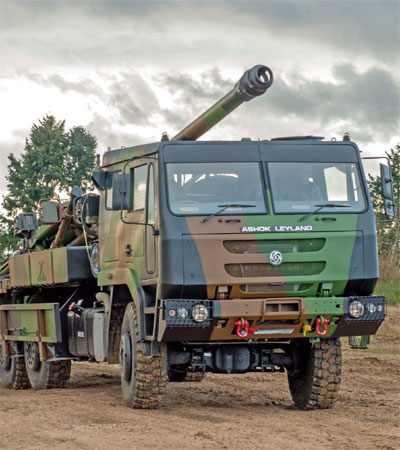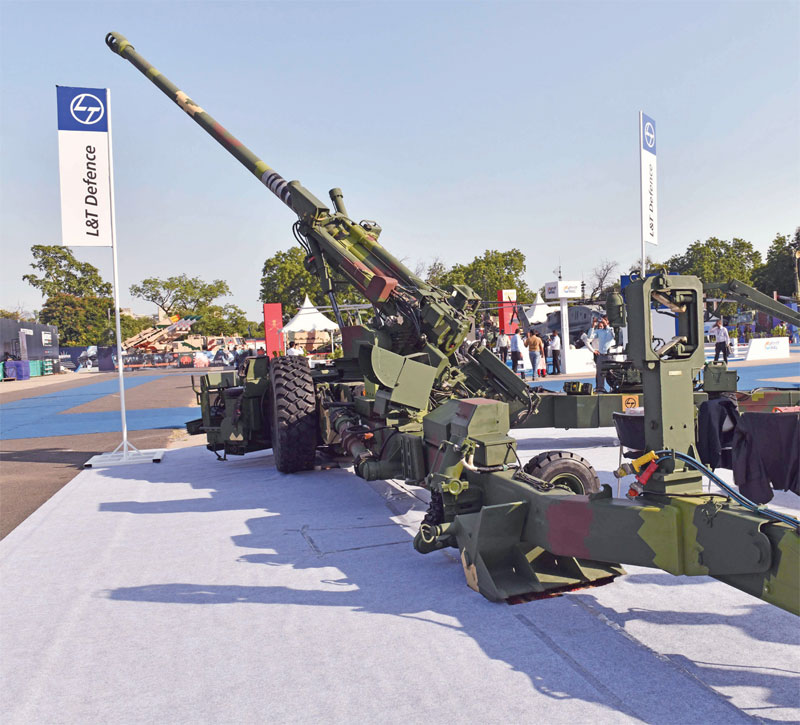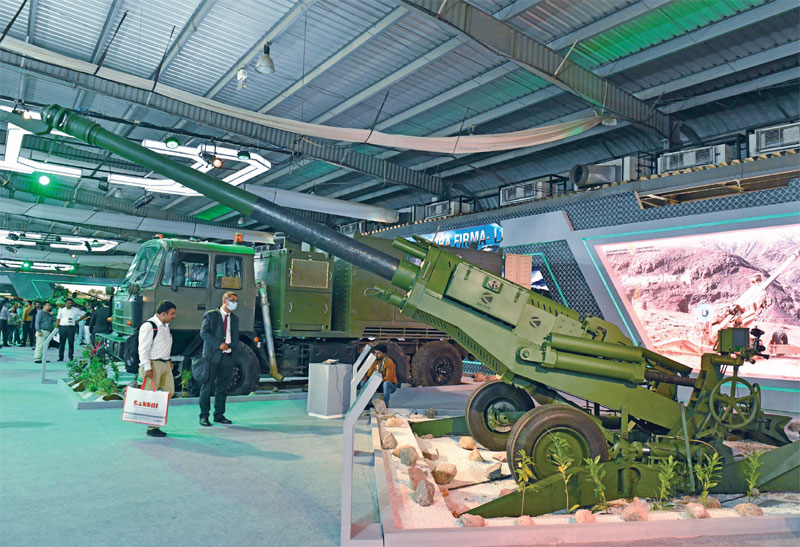With China not backing down from aggressive action on the border, modern guns are urgently required
 Lt Gen. B.S. Pawar (retd)
Lt Gen. B.S. Pawar (retd)
The artillery modernisation push goes back to 1999 when the army’s Field Artillery Rationalisation Plan (FARP) was formulated and finalised, which involved the induction of 2800 x 155mm varied gun systems by 2027. This included 1580 towed guns, 814 mounted gun systems, 180 SP wheeled/ 100 SP tracked guns and 145 ULH, as well as multi-barrel rocket systems, missiles, surveillance and target acquisition systems, though the emphasis remained on the gun systems.
For almost two decades the FARP remained only on paper and there was hardly any movement forward. But over the last five years the induction of two modern and advanced gun systems, the M777 Ultra Light Howitzer (ULH) and the K9 Vajra Tracked Self Propelled (SP) Gun and the development of two major indigenous towed gun projects like the Dhanush (Upgraded Bofors) by the Ordinance Factory Board (OFB) and the Advanced Towed Artillery Gun System (ATAGS) by the Defence Research and Development Organisation (DRDO) saw the FARP finally taking shape and set the ball rolling on the long stagnating artillery modernisation process.
The final trials and evaluations in February 2019 of the principle project to acquire 1,580 state of the art towed guns, gave a further impetus to the modernisation drive–Israeli Elbit Systems ATHOS gun emerged as a clear winner. In fact, in 2019 the artillery was the only arm of the army whose modernisation process was on track, but that short dream run is now history. Barring the M777 ULH and the K9 Vajra all other projects are either facing delays or have been scrapped by the government citing the need for Aatmanirbarta and due to the negative import lists generated by the ministry of defence (MoD) for acquisition of military hardware with the artillery gun systems being included in the same.
The Wheeled SP gun project has already been shelved, there has been no forward movement on the Mounted Gun Systems and as per reports the most important project of Towed Guns is as good as dead. As a result, the artillery will continue to operate the old Indian Field Gun (IFG) and the Light Field Gun (LFG), which form the bulk of the artillery’s inventory with limited ranges and automation. To further add to the woes the indigenous Dhanush gun is facing some technical issues and is way behind in its committed production schedule delivering only 18 guns against an order for 114 over the last four years.
Keeping this in mind, major concerns on the slow pace of modernisation were raised by the erstwhile Director General Artillery as early as 2021 and more recently the same has been endorsed by the Comptroller and Auditor General (CAG) with his scathing and critical observations on the lack of progress in the implementation of the FARP. As per the CAG, only eight per cent of the total 2,800 guns have been acquired so far. The delays in the modernisation programme are even more concerning as India now has domestically developed state of the art design and production facilities for artillery guns.
Howitzers/ Gun Systems
M777 ULH & K9 Vajra SP Gun: Two Projects stand out for their successful fructification and smooth implementation, namely the US BAE Systems M777 ULH (155mm/39 Calibre) and the Korean Samsung Techwin’s K9 Thunder, now called the K9 Vajra-T tracked SP gun (155mm/52caliber).
The M777 ULH is ideally suited for mountainous and high altitude terrain and is capable of being airlifted under slung by Chinook helicopters to the mountains, which gives it tremendous operational flexibility. The contract was signed in November 2016 by BAE’s partner Mahindra Defence Systems and the gun was formally inducted into the army in November 2019. All 145 guns have been inducted and these units are currently deployed and are playing a crucial role in our northern and eastern borders. The K9 Vajra-T gun system is being produced in India by Larsen & Toubro (L&T) in collaboration with the Korean partner and the contract was signed in 2017 for 100 tracked SP guns, with the first three guns being inducted in November 2019.

All 100 guns were delivered as per schedule by 2021 with some of them now being deployed in the Ladakh sector though their acquisition basically was to cater to the strike corps operations in the desert sector. As per reports the Defence Acquisition Council (DAC) has already given sanction for an additional 100 x K9 Vajra SP guns and the contract with L&T is likely soon. Their manufacture and induction are likely to be faster as no trials are required. The army is likely to go in for another 100 guns subsequently to cater to the shortfall created by the shelving of the wheeled SP project a few years back.
Towed Howitzer-155mm/52 Calibre: This was the major project of the FARP involving the induction of 1,580 modern and state of the art howitzers to basically replace the inventory of IFG, LFG and the few Russian origin 122mm field guns, which have limited range, automation and flexibility for use of different types of ammunition. The acquisition process had finally reached the culmination stage in 2019, after almost five years of relentless trials and evaluations. The project involved direct supply of 400 guns followed by the indigenous manufacture of the remaining 1,180 guns by the OFB under a full transfer of technology. In this long-drawn process, the Israeli Elbit Systems ATHOS gun finally emerged as the clear winner. It would be prudent to mention here the price quoted by Elbit for ATHOS is even lower than the Dhanush gun.
The significant feature of this project has been the involvement of major private sector defence companies who tied up with foreign vendors–Bharat Forge with Elbit and L&T with Nexter. But despite four years since the culmination of trials no decision has been taken on this project by the government. With artillery guns now under the negative import list and the thrust on Aatmanirbharta in defence acquisition, this critical project can be considered as good as dead.
This despite the army raising the red flag regarding the urgent need to fill the critical operational voids existing in the available artillery resources on our northern borders, especially in terms of medium artillery. Keeping this reality in mind and in view of the unpredictable security situation on our northern borders the army has been pressing the government to fast track the direct import of 400 ATHOS guns to overcome the operational voids in the medium artillery in high altitudes despite the negative import list–there has been no progress on that so far.
Dhanush Project 155mm/45 Calibre: This upgraded version of the Bofors called the Dhanush is being produced by the OFB and was formally inducted into the artillery (six guns) in 2019, which have been through extensive exploitation trials with consistent hand holding by the army. Initially there were major issues related to the barrel and the auxiliary power unit (APU) but these have now been resolved, though a few technical issues still remain. An indent has already been placed with the OFB for 114 howitzers. However, a major concern is the abysmal pace of manufacturing by the OFB, having delivered only 18 guns against the 114 ordered in 2018. This issue needs to be addressed by the OFB. A way forward could be to involve private entities who have the experience and expertise in this field and move ahead jointly to increase the production capacity.

ATAGS: The ATAGS is a 155mm/52 Calibre towed gun system developed by the DRDO with the involvement of two major private sector entities, Bharat Forge and Tata Power SED. The prototypes by Bharat Forge and Tata Power SED have undergone extensive development and user trials since 2020. The gun had faced some development issues, which have since been rectified and it has been cleared for induction. While the initial indent placed was for 150 guns to be manufactured by Bharat Forge and Tata Power SED, the same has now been increased to 307 ATAGS. There is no doubt that that the ATAGS will be the main stay of the artillery in the coming two to three decades, however the reality is that it is still a work in progress and its induction is at least two-three years away.
Sharang Project: Another very significant project is the upgrading of the Russian 130mm/39 Calibre M46 guns to 155mm/45 Calibre called the Sharang. Under this project the MoD has given approval for upgrading 300 M46 guns. The contract was awarded to the OFB in 2018 and the first Sharang was handed over to the army in 2021. As per reports, four regiments have already got the guns and the Sharang project is on track with all 300 guns expected to be upgraded by 2024. A similar project to upgrade 180 x M46 guns was also undertaken earlier in 2004 called the Soltam, in which the kit for up gunning was acquired from Soltam of Israel–180 Soltam guns are in service with the artillery. However, in the case of Sharang, the up-gunning kit is being manufactured by OFB itself. Both these guns have enhanced range and commonality of ammunition with the other 155mm systems and will provide a boost to towed artillery capability but they in no way compare with the advanced and state of the art systems like the ATHOS or the ATAGS.

Rockets & Missile Systems
The developments in the rocket artillery and missile arena have been very encouraging, especially in view of the importance and impact of the long range weapon platforms in the ongoing Ukraine conflict. The upgrading of the vintage Russian origin Grad BM 21 Multi Barrel Rocket System (MBRL) in terms of range, accuracy and a more powerful mount has made this 40 tube rocket system more agile and lethal, it is operated by both Russia and Ukraine in the ongoing conflict.
The indigenously developed and manufactured Pinaka MBRL System is already in service and is performing exceedingly well. Presently, there are four units operational and another six have been sanctioned, which will have an enhanced range of 75 km against the present 40 km. This development is already ongoing and this increased range will greatly enhance the strategic value of the weapon system. The Pinaka MBRL is being produced both by Tata and L&T, pointing towards greater involvement of the private sector in defence manufacturing. The artillery already boasts of three units of the Russian Smerch MBRL with a range of 90 km and is looking at ways and means to enhance the same to 120 km.
In the missile field we have the Prithvi and the Prahar tactical missiles with ranges up to 150 km. However, it is the BrahMos supersonic cruise missile with a range of 290 km which greatly enhances the strategic reach of the Indian Army. Plans are already afoot to develop a new generation of BrahMos missiles with 800 km range, which will eventually be extended to 1,500 km. While the DRDO had test fired the upgraded version of missile for a range of 800 km in November 2020, this project is still a work in progress and will take some time to fructify. The DRDO is also looking at developing the hypersonic version of the BrahMos over the next 7-8 years. Major increases in the ranges of the Pinaka rocket system and the BrahMos cruise missile will greatly enhance the firepower reach of the Indian Army and will be a game changer in future conflicts.

Ammunition
The Kargil war exposed our vulnerability to ammunition shortage to sustain even a short-term conflict and even now in the ongoing standoff with China the government had to invoke emergency financial powers to acquire ammunition to meet the acute operational requirement of the forces. The government is addressing this issue on a priority with the active involvement of the public-private sector entities in manufacturing. The artillery is also looking at acquisition of smart ammunition, especially Precision Guided Munitions (PGMs), which have the capability to hit targets with a very high rate of accuracy thereby ensuring first round hit probability and destruction.
Currently, the artillery has in its inventory the Russian laser guided Krasnopol shells and the recently acquired GPS guided M982 Excalibur PGMs from Raytheon in the US–1,200 shells were acquired in 2019 and the acquisition of additional shells is in the pipeline. While this will act as a tremendous force multiplier, it needs to be remembered that this ammunition can only be fired from the ULH howitzers, which are limited in numbers.
Capability Gap
The artillery today faces a critical capability gap in its modernisation programme and the efforts, if any, to bridge this gap presently are woefully inadequate. The CAGs critical comments and observations on the state of artillery’s modernisation process should send alarm bells ringing in the concerned quarters and spur them into immediate action to address the problem areas and find viable solutions.

The major contributing factor has been the rejection by the government of the 1,580 Towed Guns Project, which had reached its culmination in 2019 after two decades of numerous trials and evaluations with different modern gun systems. This step no doubt was triggered by the Aatmanirbharta thrust and the artillery guns being put on the negative import list. While the government policy to move away from imports and give a boost to indigenous capability in development and manufacture of defence equipment is a very apt and welcome step, its application should have been more thoughtful and practical keeping in mind the existing security threats being faced and the wherewithal required to meet these challenges. The towed gun project should have been kept out of this policy ambit.
On the other hand, the Dhanush still has some technical issues which need to be addressed on a priority by the OFB and more importantly it needs to ramp up its production schedule in order to meet its commitment of 114 guns. The army’s demand to directly acquire 400 ATHOS Towed Howitzers to meet the critical operational voids in our northern borders in a shorter timeframe needs to be taken note of and suitable action taken by the MoD on a priority before it is too late. There is no doubt that the ATAGS will in the long run be the mainstay of the future fire power of the artillery, but in the interim critical voids need to be filled. The state of ammunition continues to be an area of concern even though the government in a major policy shift has given licences to the private sector for development/ production of certain types of ammunition like fuses and charge systems, but a lot more needs to be done–this in fact is one area where Aatmanirbharta is the need of the hour.
With the situation along the Line of Actual Control continuing to be fragile and unstable and with China showing no signs of backing down from its aggressive actions on the border, the MoD and the army will need to address this stagnation in the artillery’s modernisation process on a fast track. The situation is alarming indeed and needs out of the box solutions, which may require tweaking of government policies if required. The time to act is now.

